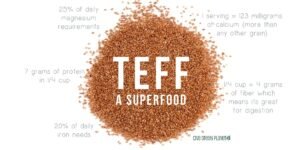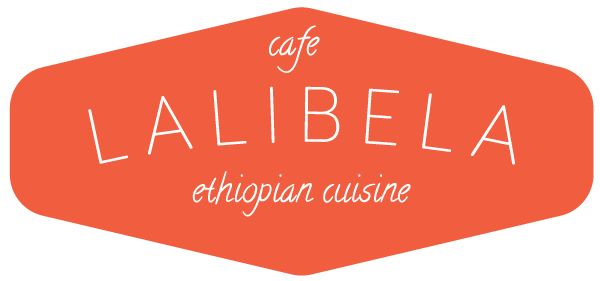Injera is more than just a type of bread—it’s the heart and soul of Ethiopian cuisine. This unique, spongy flatbread serves as the foundation of nearly every Ethiopian meal, acting as both a plate and a utensil. At Café Lalibela Ethiopian Cuisine in Tempe, AZ, injera holds a special place on our menu, and we proudly offer it in two distinct forms: one made from a mix of teff, barley, and wheat, and the other made from 100% teff, which is gluten-free. In this blog, we explore the significance of injera in Ethiopian culture and cuisine, and why it’s a must-try for anyone new to Ethiopian food.
What is Injera?
Injera is a traditional Ethiopian flatbread known for its light, airy texture and slightly tangy flavor. It is typically made from teff, a tiny, nutrient-rich grain native to Ethiopia. The process of making injera involves fermenting the teff flour batter for several days, which gives the bread its distinctive taste and spongy consistency. The fermentation process also creates the characteristic holes or “eyes” on the surface of the injera, which help to soak up the rich sauces and stews served on top.

At Café Lalibela, we offer two versions of injera to cater to different dietary preferences:
- Injera: Made from a mix of teff, barley, and wheat, this version offers a balanced flavor and texture, making it the perfect companion for the diverse dishes on our menu.
- 100% Teff Injera: For those seeking a gluten-free option, our 100% teff injera is a delicious alternative. Teff is naturally gluten-free, retaining all the nutritional benefits of the grain while providing a pure, authentic taste.
The Cultural Significance of Injera
Injera is much more than a staple food in Ethiopia—it is deeply intertwined with the country’s culture and social practices. In Ethiopian homes, meals are typically shared from a communal platter, with injera laid out as the base. Various stews, vegetables, and meats are placed on top of the injera, and diners use pieces of the bread to scoop up the food, feeding themselves and each other.
This communal way of eating symbolizes unity, community, and respect. Sharing a meal from a single platter fosters a sense of togetherness and encourages conversation and connection. The act of breaking off a piece of injera and offering it to another person is considered a gesture of friendship and hospitality in Ethiopian culture.
At Café Lalibela, we embrace this tradition by serving our dishes on a large round of injera, allowing our guests to experience the communal aspect of Ethiopian dining. Whether you’re sharing a meal with family or friends, eating with injera brings warmth and connection to the table.
Injera as a Nutritional Powerhouse
In addition to its cultural significance, injera is also a nutritional powerhouse. Teff, the main ingredient in injera, is packed with nutrients that make it a healthy choice for diners. It’s high in dietary fiber, which aids digestion and helps maintain a healthy weight. Teff is also a good source of protein, making injera an excellent option for vegetarians and vegans. Additionally, teff is rich in essential minerals like iron and calcium, which are important for bone health and overall well-being.
At Café Lalibela, our 100% teff injera offers these nutritional benefits in a gluten-free form, catering to those with dietary restrictions without compromising on taste or texture.
Enjoying Injera at Café Lalibela
At Café Lalibela, injera is the foundation of our menu. Whether you’re enjoying spicy doro wat (chicken stew), key sega (spicy beef), yebeg alicha (lamb stew), fosolia (green beans and carrots), or tibs (pan-fried beef or lamb), injera is always served alongside, ready to scoop up the rich flavors of Ethiopian cuisine.
For those new to Ethiopian food, we encourage you to embrace the experience of eating with your hands, using pieces of injera to pick up different dishes. This traditional way of eating not only enhances the flavors of the food but also connects you to the cultural practices that have been passed down through generations.
If you’re interested in bringing the taste of Ethiopia home, you can also purchase our injera, along with other essential ingredients like berbere spice, from Market Lalibela. While making injera from scratch can be challenging, having ready-made injera allows you to recreate authentic Ethiopian meals in your own kitchen.
Conclusion: The Heart of Ethiopian Cuisine
Injera is much more than just bread—it is the heart of Ethiopian cuisine and culture. Its unique texture, tangy flavor, and nutritional benefits make it a central part of every meal, and its role in fostering communal dining and connection makes it an essential aspect of Ethiopian life. At Café Lalibela, we are honored to share this cultural tradition with our guests, offering a true taste of Ethiopia with every meal.
We invite you to visit Café Lalibela and experience the joy of eating with injera. Whether you’re a long-time fan of Ethiopian food or trying it for the first time, injera offers a delicious and meaningful way to connect with the rich culinary heritage of Ethiopia. Discover why injera is truly the heart of Ethiopian cuisine today!

Recent Comments